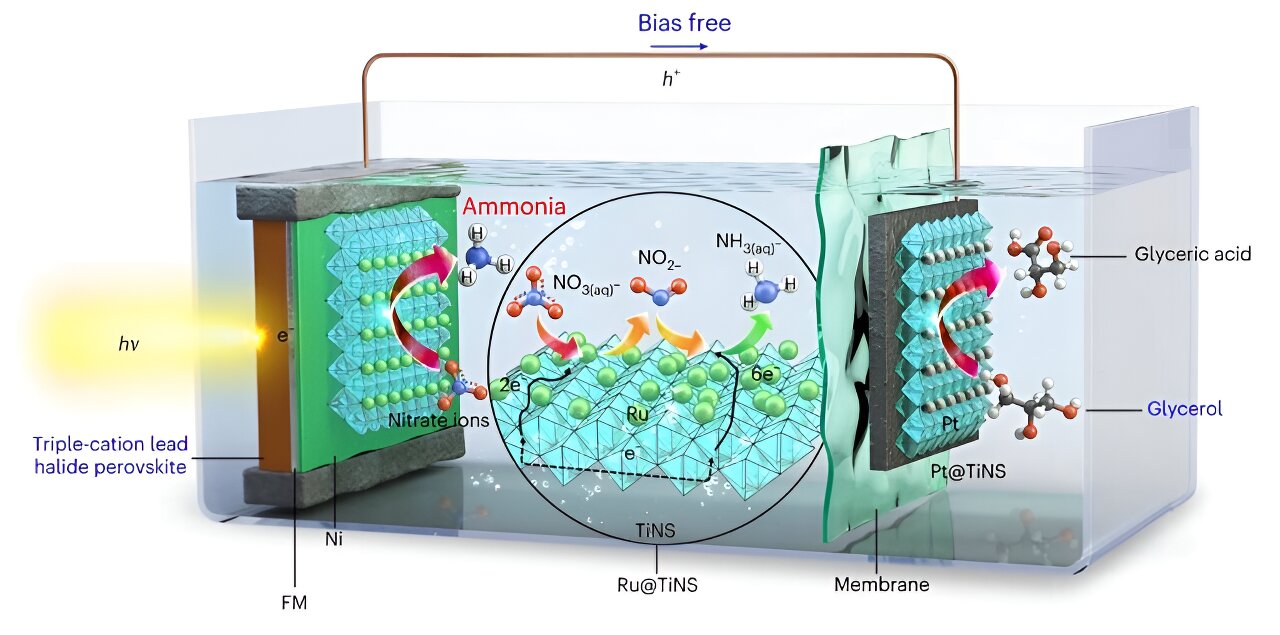#Harnessing solar energy for high-efficiency NH₃ production


A technology that harnesses solar energy to produce high-efficiency ammonia (NH3) has been unveiled by a research team affiliated with UNIST.
Led by Professor Sung-Yeon Jang and Professor Ji-Wook Jang from the School of Energy and Chemical Engineering at UNIST, in collaboration with Professor Thomas F. Jaramillo from Stanford University, the team has developed an eco-friendly perovskite-based photoelectrode system for NH3 production that has surpassed the commercialization standard of the U.S. Department of Energy (DOE) by an impressive 1.7 times, setting a new world record in ammonia production efficiency.
The work is published in the journal Nature Catalysis.
The system operates on the principle of reducing nitrate (NO3–) in water to produce NH3 using solar energy. This method not only offers a more environmentally friendly alternative to the conventional Haber-Bosch process, which heavily relies on fossil fuels, but also opens up opportunities for the synthesis of high-value compounds used in various industries such as fertilizers, food, and pharmaceuticals.
Key to the success of this technology is the development of a highly efficient photoelectrode system that combines perovskite solar cells with a ruthenium (Ru) catalyst on titanate nanosheets (TiNS). By protecting the perovskite material with Field’s metal and integrating it with the catalyst for NH3 production, the research team has achieved unparalleled performance and durability in NH3 production.
Noteworthy is the use of glycerol as a reactant, which enables the production of NH3 without the need for external voltage. By optimizing the oxidation reaction of glycerol with the voltage generated by the photoelectrodes, the team has demonstrated a remarkable maximum ammonia production rate of 1745 μgNH3 cm-2h-1, far surpassing the commercialization standard of the U.S. Department of Energy (DOE).
Professor Ji-Wook Jang said, “Through this study, we have demonstrated the production of NO3–, a main source of contamination in water, while at the same time oxidizing, glycerol, a low-value byproduct derived from biomass, to produce a higher-value glyceric acid (GA).
“This technology holds immense potential for the production of eco-friendly fuels.”
Professor Sung-Yeon Jang said, “Our research represents a significant advancement in solar fuel production, surpassing commercialization standards and paving the way for a more sustainable future in ammonia production.”
Ahmad Tayyebi et al, Bias-free solar NH3 production by perovskite-based photocathode coupled to valorization of glycerol, Nature Catalysis (2024). DOI: 10.1038/s41929-024-01133-4
Citation:
Harnessing solar energy for high-efficiency NH₃ production (2024, April 19)
retrieved 19 April 2024
from https://techxplore.com/news/2024-04-harnessing-solar-energy-high-efficiency.html
This document is subject to copyright. Apart from any fair dealing for the purpose of private study or research, no
part may be reproduced without the written permission. The content is provided for information purposes only.
If you liked the article, do not forget to share it with your friends. Follow us on Google News too, click on the star and choose us from your favorites.
If you want to read more Like this articles, you can visit our Science category.



